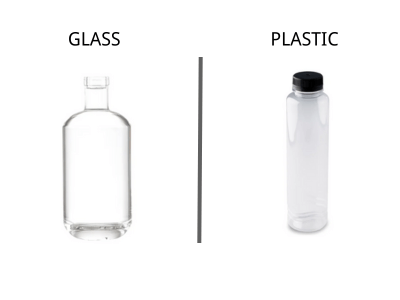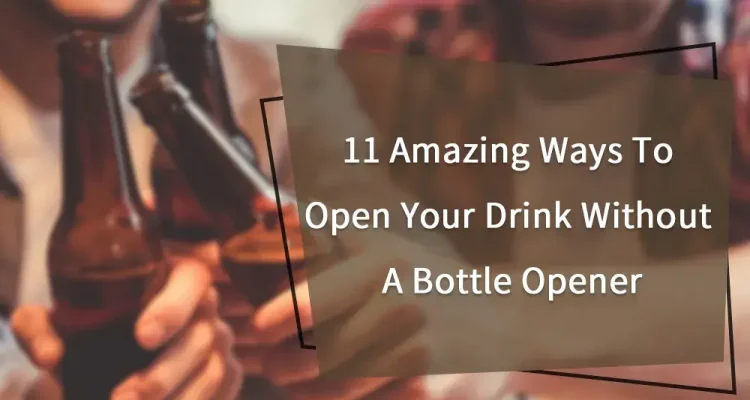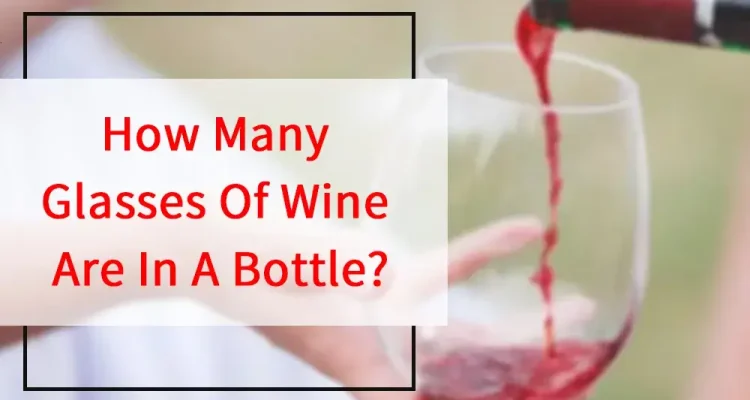You’ve probably struggled to open a bottle without a bottle opener before. Well, your struggles…
Glass VS Plastic: Which is better for packaging
When it comes to packaging consumer goods, two materials reign supreme: glass and plastic.
But which one is better?
In this in-depth article, we’ll thoroughly examine the pros and cons of both materials—from costs to durability to environmental impacts—to help you make an informed decision on the best choice for your products.
There’s a lot to unpack, so let’s get started!
A Brief History of Glass and Plastic Packaging
Before diving into the nitty-gritty comparison, let’s first look back on how these materials became so popular in packaging applications throughout history…
Glass containers have been used to store goods for thousands of years, dating all the way back to 1500 BC! Ancient Egyptians produced the first glass vessels.
And by the 8th century AD, glass manufacturing spread through Europe and Asia. Glass provided the perfect impermeable material to extend preservation and shelf life compared to ceramic pots or animal skins of the time.
However, glass was an expensive, luxury material reserved for elites until the 19th century when industrialization enabled mass production of glass bottles, jars and vials.
Machine automation in the early 1900s further accelerated glass container manufacturing.
This made glass packaging widespread and affordable for the booming food and beverage industries in the early 20th century.
Plastics packaging, on the other hand, is still a relatively new concept by comparison. The first fully synthetic plastic, Bakelite, emerged in 1907 and revolutionized the possibilities of moldable materials. But it wasn’t until the 1940s and 50s that brands like Tupperware pioneered the use of plastic containers for merchandizing consumer goods.
This coincided with chemical advancements creating the most common packaging plastics we know today – polyethylene terephthalate (PET) and high-density polyethylene (HDPE). Thanks to plastic’s light weight and shatterproof durability, adoption escalated rapidly by brands and retailers. Today, over 40% of all packaging globally contains some form of plastic.
So those are the abbreviated histories of how glass and plastic catapulted into packaging material superstardom! Next let’s scrutinize how they compare across factors like cost, sustainability, shelf appeal and more…
Popularity and Market Share
In the global packaging materials marketplace currently, plastic substantially leads glass in overall tonnage and market share.
In 2022, the global plastic packaging market was valued at USD 412 billion, while the global glass packaging market was valued at USD 62 billion.
Why the massive discrepancy?
It mainly comes down to plastic’s lightweight versatility that allows it to package everything from water bottles, takeout containers and yogurt cups to detergent jugs, medication bottles and much more.
Glass, on the other hand, primarily serves bottling applications in the food, beverage, alcohol, cosmetics and fragrance sectors.
However, glass and plastic each still play invaluable roles overall. In fact, experts forecast steady growth for both materials in coming years.
One report projects that packaging will become a $1.14 trillion industry globally in 2024 as demand and product diversity continues rising.
Cost Comparison: Evaluating the Budget Impact
Upfront product costs and profit margins are make-or-break for any business or brand. So how do glass and plastic compare when it comes to affordability in packaging applications? Which material provides the best cost value?
The truth is, it’s complicated. But let’s break this down…
Producing glass requires extremely high temperatures exceeding 2500°F to melt silica sand and other raw components like soda ash into molten glass. Plastics, in contrast, melt and mold at less than 500°F depending on variety. This substantial energy differential gets reflected in the manufacturing expenses.
By some estimates, creating new plastic resin costs 20-30% less than forming equivalent glass packaging. This gives plastic the advantage for lower initial investments into packaging materials.
However, the equation shifts when you factor in reuse and transportation costs over time. Glass is vastly more durable through repeated use cycles. And glass bottles can be up to 40% lighter than equivalent plastic containers. Given that transportation can amount to over 50% of total long-term packaging expenses, glass delivers significant savings from less breakage and fuel/emissions costs.
Additionally, recycled glass content further cuts production inputs like energy to remelt and form containers. Some analyses show that cumulative costs balance out more favorably for glass packaging with increased reuse and recycling factored in.
Essentially, glass requires higher upfront costs but pays off over numerous refill/reuse lifecycles.
While plastic is often the more budget-friendly choice initially on a case-by-case basis. What’s the verdict here?
Well, from a strictly financial perspective, both materials can make economic sense depending on the product and business models.
Sustainability and Recyclability Comparison
Of course, the ecological impact of packaging now weighs heavily in purchasing decisions as climate change concerns mount. Consumers demand assurance that brands are reducing environmental footprints. So how do glass and plastic compare by the numbers when it comes to sustainability?
As with cost, the analysis isn’t cut-and-dry…
Let’s begin with glass. Glass earns eco-points for several key reasons:
It’s endlessly recyclable without any loss of purity or quality.
Glass bottles average over 30% recycled content currently
Reusing glass containers can slash production emissions up to 90%
Glass is non-toxic if disposed in landfills.
However – the high heat requirements in manufacturing glass (over 2500°F) inevitably release substantial CO2 emissions. Glass container production globally emits 60 million tons of CO2 annually. And most glass still ends up discarded after a single use.
So what about plastics? Well, clear disadvantages exist…
Only 5-10% of plastics get recycled even once currently
It can take over 400 years for plastic to decompose naturally
Plastics release CO2 and methane emissions as it degrades
Discarded plastics severely contaminate landscapes and oceans
BUT – producing virgin plastics uses 50% less energy than manufacturing glass. And innovative new bioplastics made from plant starches help minimize environmental harms.
No universally “right” choice exists here either when comparing ecological impacts of glass against plastics. But the realities of climate change mean packaging decisions now consider sustainability above all else.
For the eco-conscious, glass likely earns slightly more green credibility. But viable plastic alternatives continue gaining ground.
Appearance and Packaging Options
Of course, packaging serves purposes beyond basic containment too – like attracting consumer eyes on crowded shelves. So how do glass and plastics stack up when it comes to versatility in shapes, forms and aesthetic presentation?
Plastic containers win hands-down for the immense diversity of options available:
Bottles, jars, jugs, tubes, blister packs, foam sheets – you name it!
Practically any color, shape, size or texture imaginable
Decorative patterns and designs easily integrated
Various opacity levels – crystal clear to fully opaque
Glass limits you mostly to bottles and rigid containers with detachable lids. Achieving intricate shapes adds production costs and breakage risks. And the “wow factor” simply doesn’t exist with glass to the levels possible with plastic packaging.
However…glass still provides that refined, upscale look and feel for industries like wines, liquors, olive oils and perfumes. The visual weight and elegance of glass bottles signals quality and stature that plastic has yet to fully replicate.
So for versatility, plastics prevail. But for premium presentation, traditional glass endures. The needs of specific brands and products should guide choices here.
The Final Verdict: Is There a Clear “Winner” Between Glass and Plastic?
We’ve now scrutinized a multitude of factors comparing the pros and cons of glass against plastic packaging. But is any one material the hands-down undisputed winner?
Unfortunately, there’s simply no universally “right” choice between glass vs plastic across every factor evaluated. Different products demand different specifications – from durability to shelf appeal to supply chain logistics and beyond.
So where does this leave us? Well, it means the quest for the “perfect” eco-friendly, high-functioning and affordable packaging solution continues…
But broader adoption of recycled materials seems non-negotiable at this point. We must transition towards predominantly recycled glass and plastic content in packaging manufacturing. And reducing unnecessary packaging elements while reusing whenever possible is also essential.
The ultimate solution likely entails combined utilization of glass, plastic and other materials like plant fibers where best suited per product. But striking the right balance remains a complex challenge with many factors at play.
Outro: –
In any case, I hope this deep dive has illuminated the glass versus plastic packaging debate and tradeoffs that brands navigate in choosing between the two!
What are your biggest takeaways?
Do you think one material claims victory overall?
I’m curious to hear your thoughts below!
And don’t forget to like this video and subscribe for regular eco-conscious content updates.
Thanks for watching!




